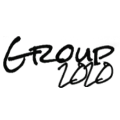Graphical models play an important role in neuroscience studies, particularly in brain connectivity analysis. Typically, observations/samples are from several heterogenous groups and the group membership of each observation/sample is unavailable, which poses a great challenge for graph structure learning. In this article, we propose a method which can achieve Simultaneous Clustering and Estimation of Heterogeneous Graphs (briefly denoted as SCEHG) for matrix-variate function Magnetic Resonance Imaging (fMRI) data. Unlike the conventional clustering methods which rely on the mean differences of various groups, the proposed SCEHG method fully exploits the group differences of conditional dependence relationships among brain regions for learning cluster structure. In essence, by constructing individual-level between-region network measures, we formulate clustering as penalized regression with grouping and sparsity pursuit, which transforms the unsupervised learning into supervised learning. An ADMM algorithm is proposed to solve the corresponding optimization problem. We also propose a generalized criterion to specify the number of clusters. Extensive simulation studies illustrate the superiority of the SCEHG method over some state-of-the-art methods in terms of both clustering and graph recovery accuracy. We also apply the SCEHG procedure to analyze fMRI data associated with ADHD (abbreviated for Attention Deficit Hyperactivity Disorder), which illustrate its empirical usefulness. An R package ``SCEHG" to implement the method is available at https://github.com/heyongstat/SCEHG.
翻译:图形模型在神经科学研究中发挥着重要作用,特别是在大脑连接分析中。一般而言,观测/样本来自若干不同组群,每个观察/样本的组群成员没有,这给图表结构学习带来了巨大的挑战。在本篇文章中,我们提出一种方法,可以实现异质图形的同质分组和估计,将非超度学习转化为监管学习。提议采用ADMMX算法解决相应的优化问题。我们还建议采用一个通用标准,以指定群集数量。拟议的SCEHG方法充分利用了脑区域之间有条件依赖关系的组别差异,以学习群集结构。实质上,通过建立区域间网络措施,我们将组合作为惩罚性的回归和偏差组合,将非超度学习转化为监管性学习。我们提议采用ADMMRB算法解决相应的优化问题。我们还提议了一个通用标准,以指定群集数量。广泛进行模拟研究,以说明SCEHHGML的实用性数据采集方法优于SCERGRM。我们运用了S-ROG的亚性数据采集方法。



